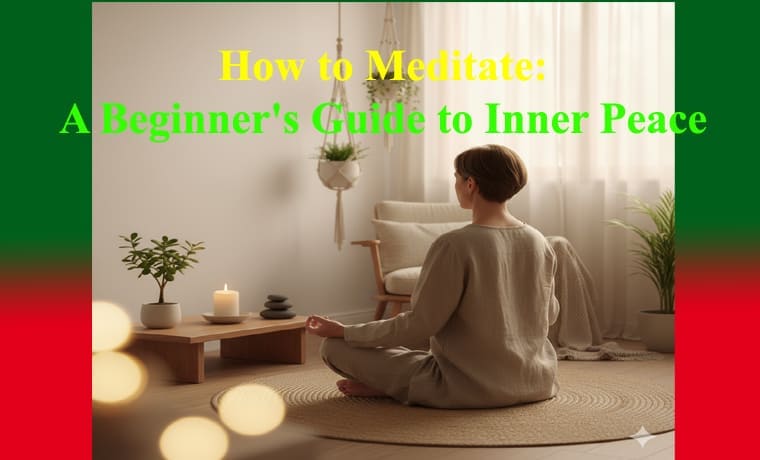Discover the transformative power of meditation! Learn how to meditate with this easy-to-follow beginner’s guide and unlock a calmer, more focused you.
How to Meditate: A Beginner’s Guide to Inner Peace
In our fast-paced world, finding moments of calm can feel like a luxury. Yet, the ancient practice of meditation offers a powerful antidote to stress, anxiety, and the constant barrage of daily demands.1 Far from being a mystical or complicated ritual, meditation is a simple technique that anyone can learn to cultivate inner peace, improve focus, and enhance overall well-being.
So, how do you meditate? Let’s explore the fundamental steps to begin your journey.
What is Meditation?
At its core, meditation is a practice of training attention and awareness to achieve a mentally clear and emotionally calm and stable state. It’s not about stopping your thoughts (which is impossible), but rather about observing them without judgment and gently bringing your focus back to the present moment.
Benefits of Meditation
The benefits of a regular meditation practice are extensive and scientifically backed:
- Reduced Stress and Anxiety: Meditation helps lower cortisol levels, the body’s primary stress hormone.
- Improved Emotional Regulation: It enhances your ability to manage emotions and react thoughtfully rather than impulsively.
- Increased Self-Awareness: You gain a deeper understanding of your thoughts, feelings, and patterns.
- Enhanced Focus and Attention: Regular practice strengthens your ability to concentrate.
- Better Sleep Quality: By calming the mind, meditation can alleviate insomnia and promote restful sleep.
- Greater Compassion and Empathy: It can foster feelings of connection and understanding towards others.
- Pain Management: Some studies suggest meditation can help alter your perception of pain.
How to Meditate: A Step-by-Step Guide for Beginners
Ready to give it a try? Here’s a simple guide to get you started: How to Meditate–
1. Find Your Space
Choose a quiet place where you won’t be disturbed. This could be a corner of your bedroom, a comfortable chair, or even a serene spot outdoors. The key is to minimize distractions.
2. Get Comfortable
Sit in a comfortable position that allows you to remain alert. You can sit cross-legged on a cushion, on a chair with your feet flat on the floor, or even lie down if that feels better for you (though be mindful of falling asleep!). Keep your spine relatively straight but not rigid. Your hands can rest gently on your lap.
3. Set a Timer
For beginners, start with short sessions – 5 to 10 minutes. As you become more comfortable, you can gradually increase the duration.10 Use a gentle timer that won’t jolt you out of your meditative state.
4. Close Your Eyes (or Soften Your Gaze)
You can gently close your eyes, or if you prefer, keep them slightly open with a soft, downward gaze, unfocused on anything particular.
5. Focus on Your Breath
This is often the anchor for meditation. Bring your attention to the sensation of your breath. Notice the rise and fall of your abdomen, the air entering and leaving your nostrils, or the feeling of your chest expanding. Don’t try to control your breath; simply observe it as it naturally is.
6. Observe Your Thoughts
Your mind will wander. This is completely normal and part of the process. When you notice your mind has drifted off into thoughts, memories, or plans, gently acknowledge them without judgment. Don’t get caught up in the story of the thought.
7. Gently Return Your Focus
Once you recognize your mind has wandered, gently redirect your attention back to your breath.11 Think of it as repeatedly bringing a playful puppy back to its mat – always with kindness and patience.
8. End with Awareness
When your timer goes off, slowly open your eyes if they were closed. Take a moment to notice how you feel. Don’t rush into your next activity. Carry a sense of calm and awareness into the rest of your day.
Tips for Success
- Be Patient: Meditation is a practice, not a destination. There will be days when your mind feels restless, and that’s okay.
- Consistency is Key: Even short, regular sessions are more beneficial than sporadic long ones. Try to meditate at the same time each day to build a habit.
- Don’t Judge Yourself: There’s no “right” or “wrong” way to meditate. Release expectations and simply show up for the practice.
- Explore Guided Meditations: Many apps and online resources offer guided meditations, which can be very helpful for beginners.
- Experiment: Try different techniques – focusing on sounds, body sensations, or a mantra – to find what resonates with you.
FAQs about Meditation
Q1: How long should I meditate each day?
A1: For beginners, 5-10 minutes a day is a great starting point. As you get more comfortable, you can gradually increase to 15-20 minutes or longer. Consistency is more important than duration.
Q2: Is it normal for my mind to wander during meditation?
A2: Absolutely! A wandering mind is completely normal. The practice isn’t about stopping thoughts but about noticing when your mind wanders and gently bringing your focus back to your anchor (like your breath).15
Q3: Do I need special equipment to meditate?
A3: No, you don’t need any special equipment. A quiet space and a comfortable place to sit are all you need. Some people enjoy using a meditation cushion (zafu) or a blanket, but they are not essential.
Q4: What if I feel restless or bored during meditation?
A4: These feelings are common. Acknowledge them without judgment, and gently bring your attention back to your breath. If you’re struggling, try a guided meditation or a shorter session. Over time, these feelings often subside.
Q5: Can meditation help with sleep?
A5: Yes, many people find that regular meditation improves their sleep quality.16 By calming the mind and reducing stress, meditation can make it easier to fall asleep and stay asleep.17 Practicing before bedtime can be particularly beneficial.
Q6: Is meditation a religious practice?
A6: While meditation has roots in various spiritual and religious traditions, it can be practiced as a secular technique for mental and emotional well-being.18 Many non-religious individuals practice meditation for its numerous health benefits.
Embarking on a meditation journey is a gift you give yourself. With a little patience and consistent practice, you’ll soon discover the profound benefits of cultivating inner peace and clarity in your daily life. 0 0 0
You May Like: Some Ways to Skill Development
We’d Love to Hear From You!
Thank you for taking the time to read our guide on “How to Meditate.”
My goal is to make this resource as helpful and clear as possible for everyone beginning their meditation journey. Your feedback is incredibly valuable in helping me achieve that.
Did you find the steps easy to follow? Is there anything you wish was explained in more detail? Do you have any personal tips that have helped you?
Please let me know your thoughts if you like the article ‘How to Meditate. Your insights will help me improve this article for future readers.
Thank you!







